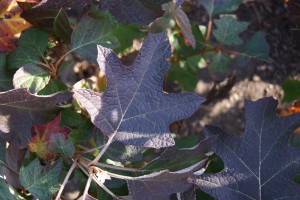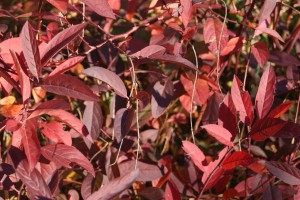What’s in Bloom
The look on the Greenway has changed dramatically in the last 4 weeks. The perennials, shrubs and trees are storing food, slowing down and readying themselves for winter. You may be doing the same – a brisk walk through the parks is an excellent way to shake off the onset of winter and our extra indulgences. There is much to see and enjoy.
What had been vibrant masses of green has become broad sweeps and blocks of color, defining and exposing the structured layers of trees and smaller shrubs throughout the Greenway. On the southern end of The North End parks, the last of the bright orange and red Fothergilla leaves stand out in front of the almost charcoal mahogany leaves of the Oakleaf Hydrangea (Hydrangea quercifolia). Layered behind these are now bare branches of Hydrangea paniculata and the rounded dark leaves and purple stems of the Smokebush (Cotinus ‘Grace’).
The Winterberry (Ilex verticillata‘Red Sprite’) has dropped most of its leaves, showing off a WOW display of bright red fruit that will put on a show for much of winter. This is a great native plant, adaptable to poor and wet soils and providing you with wonderful winter color; plus they are eye catching in arrangements on your holiday table or door! These are in the Wharf District Parks near the Aquarium, where you will also find masses of sunny yellow Summersweet (Clethera alnifolia) and stands of tawny golden and buff Switchgrass (panicum virgatum).
Another stand out for color is the Virginia Sweetspire (Itea virginica ‘Henry’s Garnet’). This hard working shrub, from our native plant group, has sumptuous, rich, dark red leaves, becoming a burnished burgundy as the weather cools even more. Itea has a draping raceme of lightly fragrant white flowers in early summer, and these flower stems add a special animated quality to the arching branches even at this late season.


